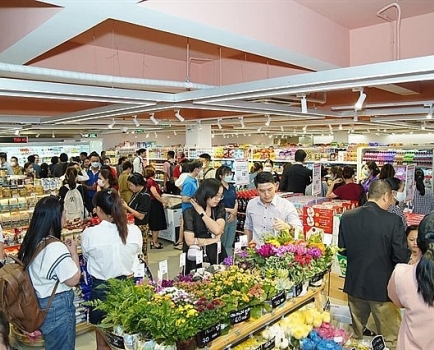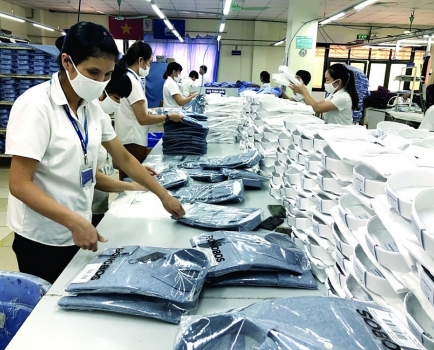Taking the initiative source of raw materials - "way out" for textile, garment and footwear export
Thu, 03 Oct 2024 16:36:00 | Print | Email Share:
 The leather, footwear and textile industries still depend heavily on imported raw materials. Photo: H.Dieu
The leather, footwear and textile industries still depend heavily on imported raw materials. Photo: H.Dieu
Still focusing on processing
According to many experts, Vietnam's textile and footwear import and export will continue to be positive in the coming months, on the one hand due to cyclical factors, demand for goods often increases sharply at the end of the year; on the other hand, export turnover to Vietnam's key markets such as the United States, Japan, South Korea, and China all increased. Fortunately, many textile and garment enterprises currently have orders until the end of 2024 and are negotiating orders for early 2025. The footwear industry is also gradually recovering with a clear increase in orders.
Mr. Pham Tuan Anh, Deputy Director of the Bureau of Industry (Ministry of Industry and Trade), said that textiles and footwear were two key export sectors of Vietnam with export turnover always growing over the years, an average increase of over 10%/year, creating nearly 5 million jobs, accounting for 22% of the labour force in Vietnam's industry.
| According to statistics from the General Department of Customs, as of September 15, textile and garment exports reached US$ 25.57 billion, up 7.75% over the same period in 2023. Leather and footwear exports reached US$ 18.44 billion, up 11.28% over the same period in 2023, of which footwear export reached US$ 15.57 billion, up 11.6%; handbags, wallets, suitcases, hats, umbrellas and parasols export reached US$ 2.87 billion, up 9.5% over the same period in 2023. |
Although the export turnover of the textile and footwear industry accounts for a high proportion of the total import-export turnover of the country, the contribution of domestic enterprises is still limited. More than 60% of the textile and garment export value belongs to FDI enterprises, although they only account for 24% of the number of enterprises; while in the footwear industry, FDI enterprises account for nearly 80% of the export turnover and only account for nearly 30% of the number of enterprises. In reality, the textile and footwear industry in Vietnam still focuses on processing, creating low added value. Raw materials, materials and accessories are mainly imported from foreign markets such as China, Korea, and other ASEAN countries.
The heavy dependence on imported raw materials may affect the overall development of the industry in the coming time. Currently, many countries are aiming for zero net emissions by 2050, and are imposing strict regulations on supply control. This requires products to meet a high rate of intra-bloc origin. Furthermore, the application of regulations on rules of origin stated in free trade agreements (such as EVFTA) for textiles and footwear products to take advantage of import tax exemptions in the Vietnamese market is having a great impact on domestic enterprises and FDI enterprises producing for export in Vietnam. Therefore, developing raw materials for the textile and footwear industry is very necessary.
From a business perspective, Ms. Bui Minh Phuong, CEO of PND Global Joint Stock Company, said that since the second quarter of 2024, the company's orders had increased and it was forecasted that the export turnover at the end of the year could triple compared to the beginning of the year. The company's export results in 2024 could increase by 25% compared to the plan.
One of the current difficulties of textile and garment enterprises is the sharp decrease in labour after the Covid-19 pandemic. To overcome this, enterprises tried to negotiate, secure orders and support workers with preferential policies. “Currently, we have not been proactive in the supply of raw materials and accessories. Although there are fabric suppliers in the country, they are still small and do not meet market requirements. This causes that there are many orders, but unit prices are low, so the profit margin of enterprises is very small. If the Ministry of Industry and Trade soon establishes a raw material and accessories center, enterprises will be proactive in the supply and reduce time and transportation costs significantly. From there, they will have a more competitive advantage in terms of unit prices. Enterprises can also implement the orientation of building their own brands to have higher added value than at present,” Ms. Bui Minh Phuong shared.
Need to develop sustainable sources of raw materials
From a market perspective, the representative of the Vietnam Trade Office in Canada noted that some of Canada's production and import policies might affect the production and export strategies of Vietnamese enterprises. Canada has consulted on building a roadmap to address plastic waste and pollution from the textile and garment industry. Every year, Canada imports an average of US$ 10 billion of textile and knitted products, up to US$ 12 billion in 2022 alone, and Vietnam is the second largest exporter to this market (turnover up to nearly US$ 1.6 billion in 2023 and US$ 1.8 billion in 2022).
Textiles are the fifth largest type of plastic waste sent to landfills in Canada. As part of a comprehensive plan to reduce plastic waste and pollution, the Government of Canada has launched a consultation seeking feedback on developing a roadmap to address textile pollution that requires enterprises to find solutions to redesign, reuse, repair and keep textiles in the circular economy for as long as possible.
Based on the actual support activities of associations in the textile, footwear and fashion sectors as well as the reality of US enterprises, the Vietnam Trade Office in the US recommends that enterprises should be proactive in finding and using sources of raw materials with traceability, meeting the requirements of sustainability and social responsibility. Regarding the establishment of industry supply centers, associations in the textile, footwear and fashion industries should base on reality, forecast future trends, determine the functions, location and model of the supply center for the fashion industry to ensure that the center is formed, operates effectively, and is able to adapt to the rapid changes of this industry from technology, production chain models, management as well as high requirements from the market, consumers, and regulations of importing countries.
The Vietnam Industrial Development Strategy to 2025, with a vision to 2035, issued under Decision No. 879/QD-TTg dated June 9, 2014, identified textiles and footwear as two of the seven priority sectors of Vietnam. To continue developing the sectors in the coming period, the Ministry of Industry and Trade believes that breakthrough solutions are needed to upgrade the industry value chain to create more long-term and sustainable benefits. To do that, there is no other way but to promote the development of the raw material supply market towards scale, standardization and transparency, only it can help enterprises of sectors, especially small and medium-sized enterprises, innovate and improve dynamism and efficiency, and have the opportunity to participate more strongly in the industry's supply chain.
According to Mr. Truong Van Cam, Vice President and General Secretary of the Vietnam Textile and Apparel Association, it is necessary to establish a Center for Raw Materials to serve the fashion industry. This center will support enterprises to proactively shift to a higher form of export instead of mainly processing, promote the development of the domestic textile and garment supporting industry, easily check the origin, serve the domestic fashion industry before reaching out to the world... However, according to Mr. Cam, the proposal to establish a center is not a new issue, but so far the implementation has not been successful. For example, some enterprises have invested and built raw materials but have not achieved high results, some units have had to close after a period of operation.
Therefore, from the experience of some countries such as Korea and China, Mr. Truong Van Cam recommended that the authorities support enterprises in terms of policies, resources, and land to stabilize investment for enterprises, transfer technology, and promote transactions between domestic and foreign enterprises.
Mr. Nguyen Duc Thuan, Chairman of the Vietnam Leather, Footwear and Handbag Association (Lefaso), also expressed his opinion that there should be breakthrough solutions to upgrade the industry value chain to create sustainable benefits. In particular, the solution is to build a trading center to develop raw materials and innovate the Vietnamese fashion industry in Binh Duong. When this center operates, it will help Vietnamese enterprises promote their internal strength and increase their competitiveness in the market.
By: Chau Anh/ Binh Minh, Customs News
Source: https://english.haiquanonline.com.vn/taking-the-initiative-source-of-raw-materials-way-out-for-textile-garment-and-footwear-export-31618.html
---------------------------------------------
Same category News :












